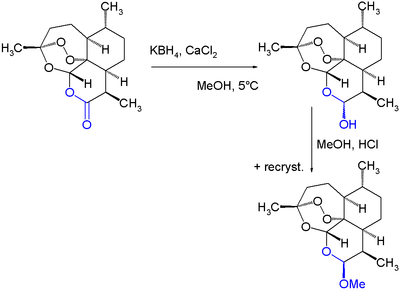Semisynthesis
Semisynthesis or partial chemical synthesis is a type of chemical synthesis that uses compounds isolated from natural sources (e.g. plant material or bacterial or cell cultures) as starting materials. These natural biomolecules are usually large and complex molecules. This is opposed to a total synthesis where large molecules are synthesized from a stepwise combination of small and cheap (usually petrochemical) building blocks.
Semisynthesis is usually used when the precursor molecule is too structurally complex, too costly or too inefficient to be produced by total synthesis. From a synthesis viewpoint, life is an amazing chemical factory, and for some chemical products, it is hard to compete with life as a synthetic route—sometimes a lowly plant can grow for pennies' worth of amortized farming investment what total synthesis would struggle expensively to produce. Thus humanity collaborates with nature to make the most of this remarkable cost-effectiveness.
Drugs derived from natural sources are usually produced by harvesting the natural source or through semisynthetic methods: one example is the semisynthesis of LSD from ergotamine, which is isolated from ergot fungus cultures. The commercial production of paclitaxel is also based on semisynthesis (see: paclitaxel total synthesis).
The antimalarial drug artemether (a component of Coartem) is a semisynthetic derived from naturally occurring artemisinin. The latter is unstable due to the presence of a lactone group and therefore this group is replaced by an acetal through organic reduction with potassium borohydride and methoxylation:[1]
See also
References
- ↑ An Improved Manufacturing Process for the Antimalaria Drug Coartem. Part IMatthias Boehm, Peter C. Fuenfschilling, Matthias Krieger, Ernst Kuesters, and Fritz Struber Org. Process Res. Dev.; 2007; 11(3) pp 336 - 340; (Article) doi:10.1021/op0602425
